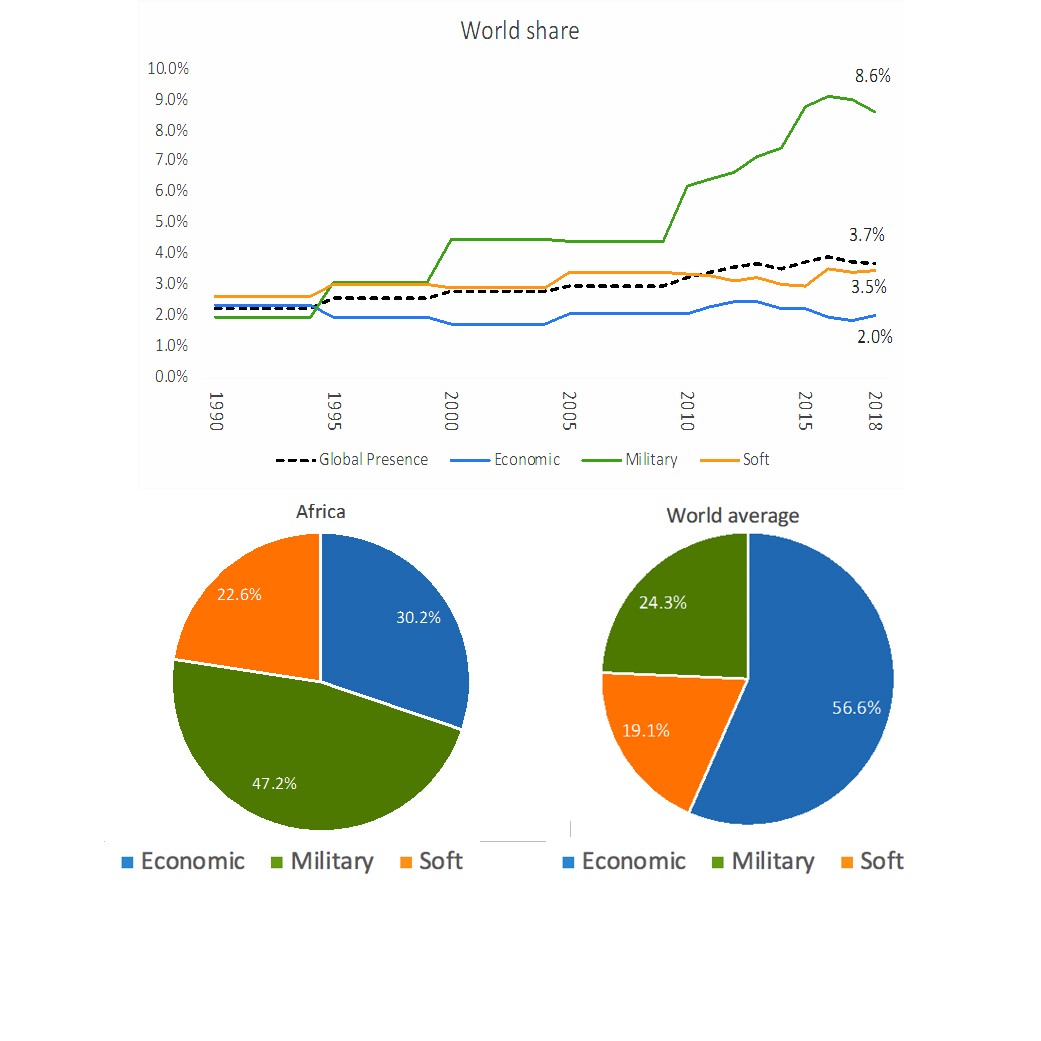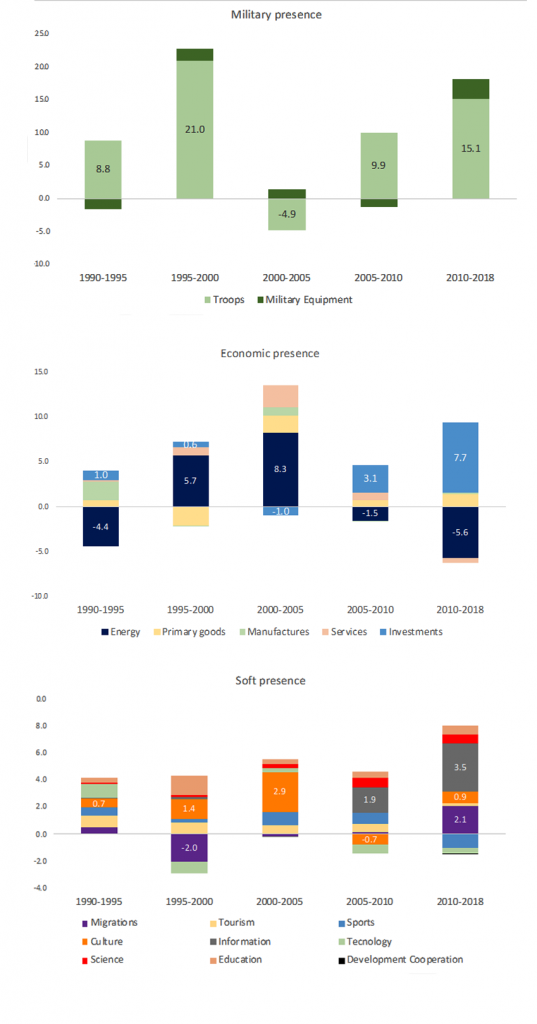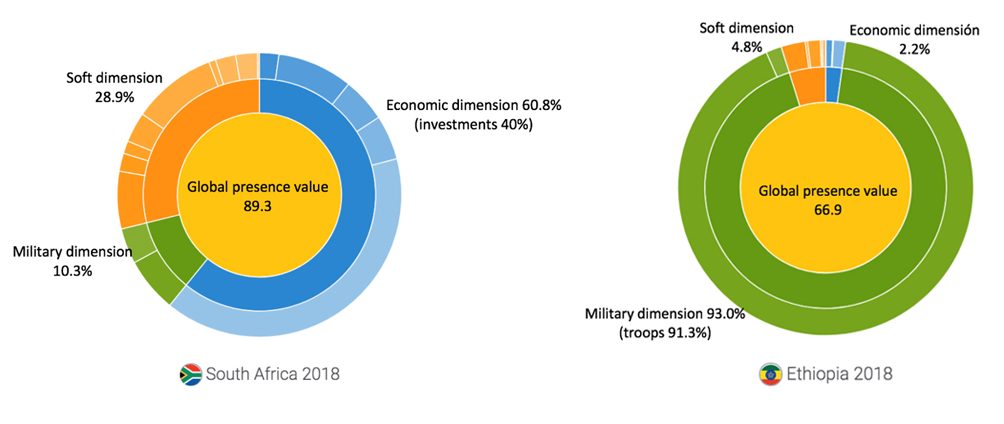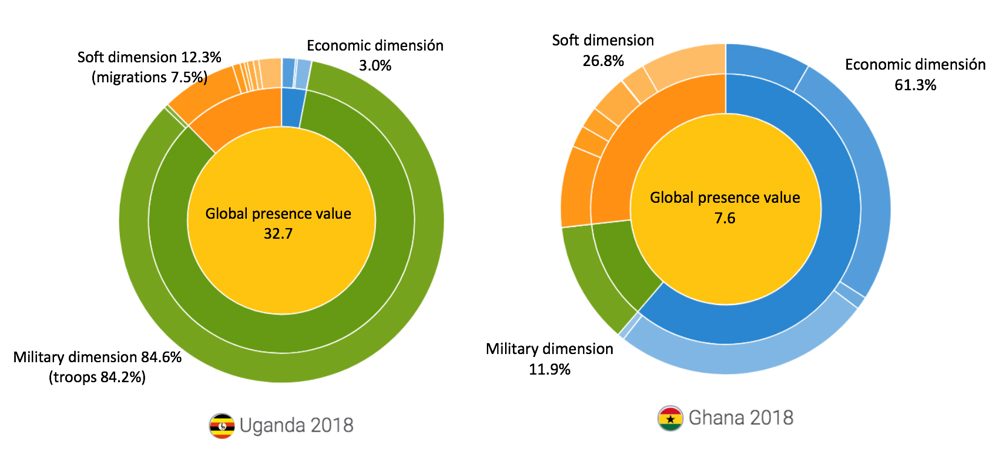
The Elcano Global Presence Index includes 28 African countries: 86.7% of the region’s GDP and 78.1% of its population. Africa has the lowest global presence but the highest growth since 1990 (+141.4%), ahead of Asia and the Pacific. Its rank is in line with its GDP but not with its population, consistent with its comparative low level of development.
Concentration: four countries (South Africa, Ethiopia, Egypt and Nigeria) account for more than 51% of the region’s external projection.

The importance of the military
- Africa’s global presence is strongly grounded on the military dimension (a 47.2% contribution[1] versus a 24.3% world average).
- Africa’s share of global presence[2] has slightly increased (to 3.7% in 2018 from 2% in 1990) due to a strong growth of the military (in the context of a more demilitarised presence of the rest).

Energy, peacekeeping missions and Nollywood
- Drivers of Africa’s global presence [3] growth are strongly influenced by energy price cycles although investments have lately played a greater role.
- Military presence has been guided by the deployment of troops abroad as a result of the contribution of African armies to UN peacekeeping missions in the region.
- The soft dimension less dynamic, with no clear drivers: culture up to the mid-2000s (Nollywood effect) and information more recently (Internet effect).

African champions
- South Africa is the only African country in the world’s top 30 ranking;[4] only four African countries are among the top 50.
- Ethiopia ranks 2nd in the region, with a strong rise, ahead of Egypt and Nigeria.
- Some significant up-scalings: Uganda (+40 positions since 1990), Burkina Faso, Ghana, Senegal and Kenya.
- Some sharp drops: Libya, Zimbabwe and Congo D.R. Six African countries are among the world’s lowest 10.
| 2018 | Var. 1990-2018 | |
|---|---|---|
| South Africa | 29 | +14 |
| Ethiopia | 33 | +28 |
| Egypt | 41 | +9 |
| Nigeria | 47 | +1 |
| Uganda | 51 | +40 |
| Morocco | 52 | -20 |
| Kenya | 57 | +11 |
| Argelia | 58 | -5 |
| Angola | 71 | -12 |
| Senegal | 72 | +12 |
| Burkina Faso | 79 | +20 |
| U.R Tanzania | 80 | +2 |
| Tunisia | 81 | -11 |
| Côte d’Ivoire | 85 | -21 |
| Sudan | 86 | -15 |
| Ghana | 87 | +16 |
| Zambia | 94 | -9 |
| Libya | 95 | -46 |
| Cameroon | 96 | -20 |
| Gabon | 101 | -20 |
| Congo, D.R | 102 | -27 |
| Botswana | 109 | -20 |
| Zimbabwe | 111 | -34 |
| Mauritius | 114 | -19 |
| Mozambique | 116 | -10 |
| Namibia | 117 | -17 |
| Mali | 118 | -13 |
| Equatorial Guinea | 120 | -12 |
Elcano Global Presence Index, Elcano Royal Institute
Different countries, different global presence profiles
- South Africa: a regional economic power with a strong soft presence.
- Ethiopia: with one of Africa’s biggest armies, the country is the main contributor to UN peacekeeping missions in the region.

Silent, though emerging: Uganda and Ghana
- Uganda: a heavyweight in the military dimension – again due to the deployment of troops.
- Ghana: an important exporter of primary goods and ICT services.

[1] The contributions to presence are the magnitude that each dimension or indicator represents in the global value of a country’s presence, expressed as a percentage of that country’s total global presence.
[2] The share or quota of presence represents the weight of a country’s presence record –global or by dimensions– over the added record of all countries.
[3] This driver value shows the real contribution of each variable to global presence growth, calculated by multiplying the growth of each individual variable by its weight over total global presence in the previous year.
[4] The world ranking includes 120 countries.



